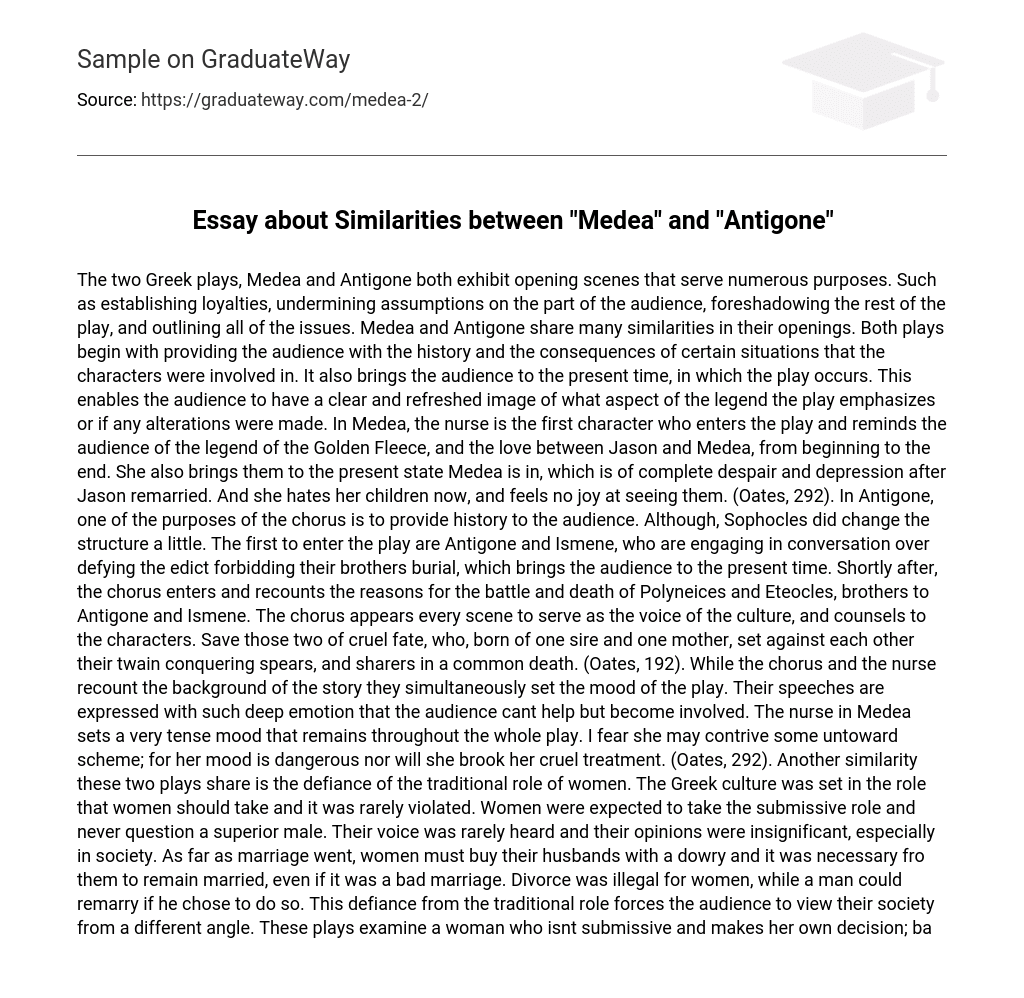Both Medea and Antigone, the two Greek plays, present opening scenes that serve multiple purposes. These include establishing loyalties, challenging audience assumptions, foreshadowing the rest of the play, and highlighting all of the issues at hand. The openings of Medea and Antigone display several similarities.
Both plays begin by providing the audience with the history and consequences of certain situations involving the characters. This also brings the audience to the present time in which the play takes place. By doing so, the audience gains a clear understanding and updated image of the specific aspect of the legend that the play emphasizes or any alterations that may have been made. In Medea, the nurse is the first character to appear and she reminds the audience of the legend of the Golden Fleece and the love between Jason and Medea from beginning to end. She also brings them to the current state of despair and depression that Medea is experiencing after Jason’s remarriage.
According to Oates (292), the character feels a deep dislike towards her children and no longer feels any happiness when she sees them. In the play Antigone, the chorus serves the purpose of providing historical context to the audience. However, Sophocles made some alterations to the play’s structure. Antigone and Ismene are the first to appear in the play, engaging in a conversation about their disobedience towards the edict that prohibits the burial of their brothers. This dialogue brings the audience to the present moment.
Following shortly after, the chorus makes its entrance and provides an account of the reasons behind the battle and demise of Polyneices and Eteocles, who are the brothers of Antigone and Ismene. The chorus reappears in every scene to act as the cultural voice and offer guidance to the characters. Except for those two individuals who were doomed by fate, being born from the same father and mother yet becoming adversaries with their battling spears, ultimately leading to their shared demise (Oates, 192).
The chorus and the nurse in Medea not only provide background information but also establish the mood of the play. Their powerful speeches evoke deep emotions from the audience, drawing them into the story. The nurse’s intense demeanor throughout the entire play creates a tense atmosphere. There is a sense of fear that she may plot something unfavorable, as her mood is threatening and she refuses to tolerate her cruel mistreatment (Oates, 292).
Both plays share a similarity in the defiance of the traditional role of women in Greek culture. In this society, women were expected to be submissive and never question men in positions of authority. Their opinions and voices held little significance, particularly in society. Furthermore, women were required to purchase their husbands through a dowry and were obligated to stay married, even in the case of an unhappy marriage.
Divorce was prohibited for women, whereas men were allowed to remarry at their discretion. By challenging traditional societal norms, these plays prompt the audience to reconsider their understanding of society. They explore the story of a non-submissive woman who exercises her autonomy and follows her personal convictions instead of conforming to societal expectations. Overall, Antigone’s character is characterized as obstinate, furious, inflexible, and prioritizing her family and religious beliefs over the state. The initial exchange between Antigone and Ismene revolves around Creon’s decree that bans the burial of Polyneices.
Antigone confides in her sister and asks for her help in defying the order. Ismene reminds Antigone that as women, they are not strong enough to defy the state. However, Antigone prioritizes her loyalty to her brother and the law of the gods above the state. She is willing to die for Polyneices’ burial. Antigone is driven by instincts, emotions, and extreme pride. She believes she will rest in peace beside her loved one, committing a sinless crime, as she feels a stronger allegiance to the dead than to the living. Antigone implores Ismene to not dishonor laws established by the gods if she so chooses.
(Oates, 189). Medea examines a female who goes against the traditional role. She is depicted as a violent, savage woman who will go to any lengths to harm her enemies. She challenges the role of women in society and disagrees with their inferior treatment. And yet they say we live safely at home, while they are at war, with their feeble justifications, because I would rather fight in battle three times over than give birth once. (Oates, 298).
Sophocles’ Antigone and Euripides’ Medea are Greek plays that have several similarities. The plays share commonalities in how they inform the audience about history and challenge traditional gender roles. These recurring themes in Greek tragedy are directly influenced by the society in which they were written.





